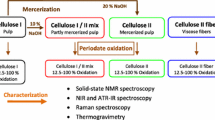Abstract
In order to obtain information about the crystallinity and polymorphs of cellulose, and the occurrence of hemicelluloses in pulp fibers, wood cellulose, bacterial cellulose, cotton linters, viscose, and celluloses in different pulps were investigated by solid state 13C CPMAS NMR spectroscopy. A mixed softwood kraft pulp and a dissolving-grade pulp were treated under strongly alkaline and acidic conditions and the effect on cellulose crystallinity was studied. The presence of different crystalline polymorphs of cellulose and the amounts of hemicelluloses are considered.
Similar content being viewed by others
References
Björkman, A. (1956) Studies of finely divided wood. Part I. Extractions of lignin with neutral solvents. Svensk Papperstid 60, 477-485.
Bucher, H. (1957) Zu den Vorgängen bei der Pergamentierung von Zellstoff mit Schwefelsäure. Das Papier 11, 125-133.
Cael, J. J., Kwoh, D. L. W., Bhattacharjee, S. S. and Patt., S. L. (1985) Cellulose crystallites: A perspective from solid state NMR. Macromolecules 18, 819-821.
Debzi, E. M., Chanzy, H., Sugiyama, J., Tekely, P. and Excoffier, G. (1991) The I? to I? transformation of highly crystalline cellulose by annealing in various mediums. Macromolecules 24, 6816-6822.
Evans, R., Newman, R. H. Roick, U. C. Suckling, I. D. and Wallis, A. F. A. (1995) Changes in cellulose crystallinity during kraft pulping, Comparison of infrared, X-ray diffraction and solid state NMR results. Holzforschung 49, 498-504.
Ferrige, A. G., Lindon, J. C. (1978) Resolution enhancement in FT NMR through the use of a double exponential function. J. Magn. Res. 31, 337-340.
Hattula, T. (1986) Effect of kraft cooking on the ultrastructure of wood cellulose. Paperi ja Puu. 926-931.
Hausalo, T. (1995) Analysis of wood and pulp carbohydrates by anion exchange chromatography with pulsed amperometric detection. In: 8th International Symposium of Wood and Pulping Chemistry. Helsinki. Proceedings Vol III, pp. 131-136.
Hemmingson, J. A. and Newman, R. H. (1995) Changes in molecular ordering associated with alkali treatment and vacuum drying of cellulose. Cellulose 2, 71-82.
Horii, F., Hirai, A. and Kitamura, R. (1982) Solid-state high-resolution 13C-NMR studies of regenerated cellulose samples with different crystallinities. Polym. Bull 8, 163-170.
Isogai, A., Usuda, M., Kato, T., Uryu, T. and Atalla, R. H. (1989) Solid-state CP/MAS 13C NMR study of cellulose polymorphs. Macromolecules 22, 3168-3172.
Janson, J. (1974) Analytik der polysaccharide in Holz und Zellstoff. Faserforschung und Textiltechnik 25, 375-382.
Kai, A. and Mondal, I. H. (1998) Structure of nascent microbial cellulose III. Different influence of direct red 75 and 79 on nascent microbial cellulose. Polym. J. 30, 398-403.
Larsson, P. T., Wickholm, K. and Iversen, T. (1997) A CPMAS 13C NMR investigation of molecular ordering in celluloses. Carbohydrate Res. 302, 19-25.
Lennholm, A., Larsson, T. and Iversen, T. (1994) Determination of cellulose I? and I? in lignocellulosic materials. Carbohydrate Res. 261, 119-131.
Lennholm, A., Wallbäcks, L. and Iversen, T. (1995) A 13C-CP/MAS-NMR-spectroscopy study of the effect of laboratory kraft cooking on cellulose structure. Nord. Pulp Pap. Res. J. 10, 46-50.
Maunu, S., Liitiä, T., Kauliomäki, S., Hortling, B. and Sundquist, J. (1998) The investigation of cellulose polymorphs in different pulps using13C CPMAS NMR. Proc Cellucon 98. Turku. To be published.
Newman, R. H. (1998) Evidence for assignment of13C NMR signals to cellulose crystallite surfaces in wood, pulp and isolated celluloses. Holzforschung 52, 157-159.
Newman, R. H. (1994) Crystalline forms of cellulose in softwoods and hardwoods. J. Wood Chem.Technol. 14, 451-466.
Ryti, N., and Skogman, R. (1963) Beitrag zur Kenntnis des Pertgamentierprozesses mit Schwefelsäure. Papper och Trä. 4, 181-190.
ScanT P3:93, Scandinavian Pulp, Paper and Board Testing Committee, ISO-Brightness.
Scan-CM 15:88, Scandinavian Pulp, Paper and Board Testing Committee, Pulp Viscosity.
Scan-C 34:80,, Scandinavian Pulp, Paper and Board Testing Committee, Alkaliresistance.
Shibazaki, H., Saito, M., Kuga, S. and Okano, T. (1998) Native cellulose II production by Acetobacter xylinum under physical constraints. Cellulose 5, 165-173.
Sjöström, E. (1993) Wood Chemistry, Fundamentals and Applications, 2nd Edn., Academic Press, NewYork.
Wickholm, K., Larsson, P. T. and Iversen, T. (1998) Assignment of non-crystalline forms in cellulose I by CP/MAS13C NMR spectroscopy. Carbohydrate Res. 312, 123-129.
Wickholm, K., Lennholm, H., Larsson, T. and Iversen, T. (1996) Hydrolysis of cellulose samples studied by13C-CP/MAS-NMR-spectroscopy and chemometrics. Extended abstracts of 4th EWLP, Stresa, pp. 21-25.
Author information
Authors and Affiliations
Rights and permissions
About this article
Cite this article
Maunu, S., Liitiä, T., Kauliomäki, S. et al. 13C CPMAS NMR investigations of cellulose polymorphs in different pulps. Cellulose 7, 147–159 (2000). https://doi.org/10.1023/A:1009200609482
Issue Date:
DOI: https://doi.org/10.1023/A:1009200609482




